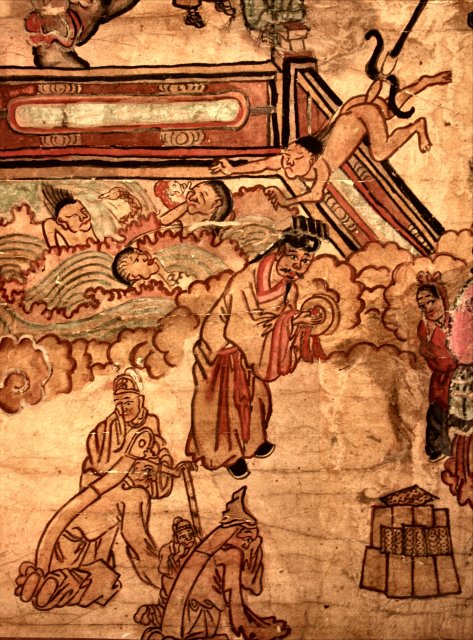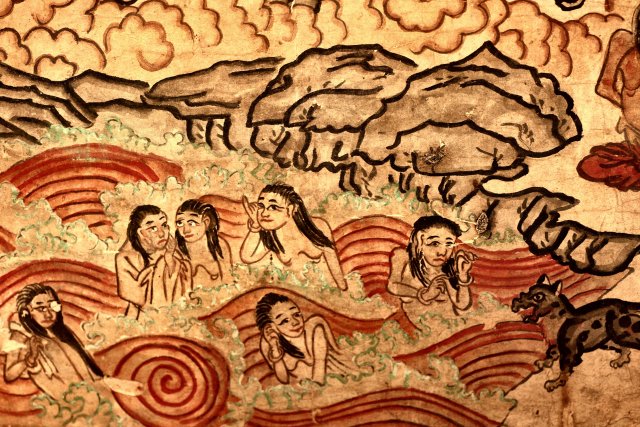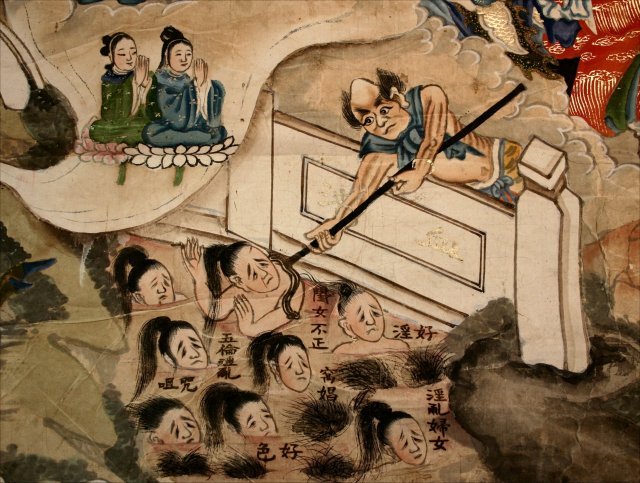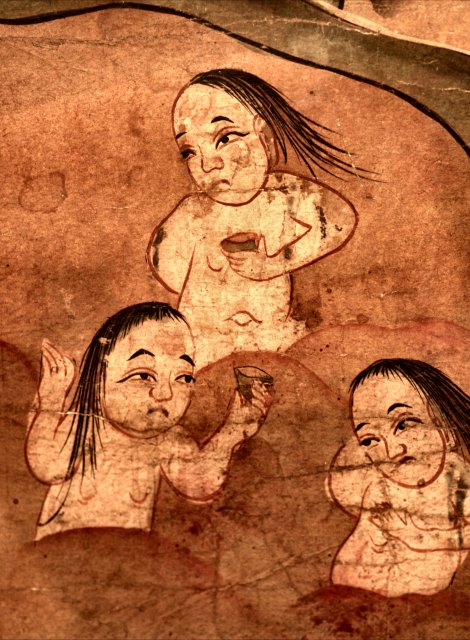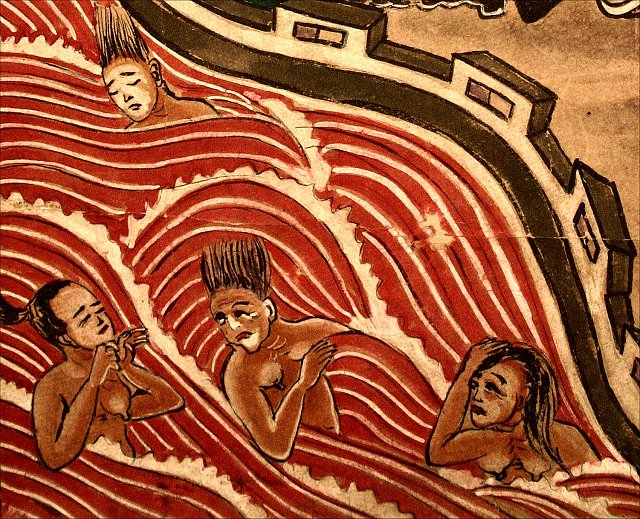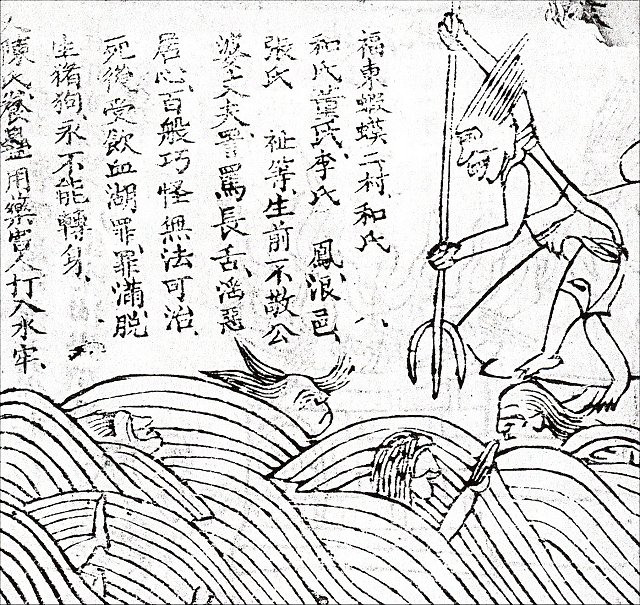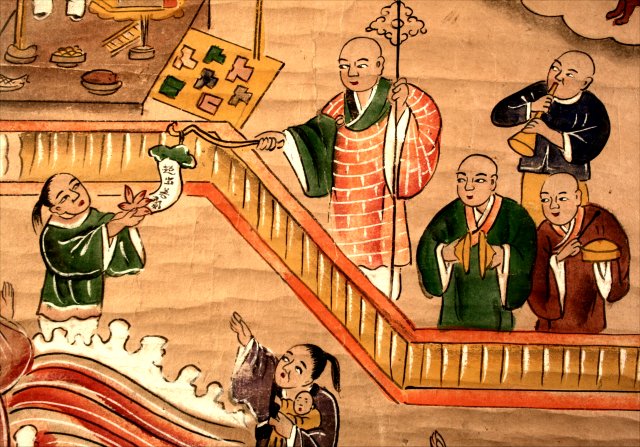
Translation
The pool of Blood and Filth
Appearance in a Taiwanese visit to hell
For a description of the Pool of Blood and Filth from a Taiwanese spiritual medium who had engaged in a series of hell tours between 1976 and 1979, see Voyages to hell, Chapter 61. Interestingly, this lengthy account of touring hell (which weighs in at 429 pages) only appends this description at the end, even though almost every set of hell scrolls focuses on it. This account also insists that it's not for mothers dying in childbirth and is not earmarked for any particular sin, as if it is arguing against tradition.Almost all of the women in this pool of filth and blood hold infants, alluding to the fact that shedding blood upon the ground -- even while giving birth -- was considered a kind of ritual pollution. Other scrolls (for example see Donnelly, p. 87) here provide a list of sins that includes having a baby out of wedlock, engaging in illicit relations out of doors, washing menstrual clothing in the river and entering into the kitchen within a month of giving birth. The cartouche on still another states that women who died during pregancy suffered great punishment after death, beaten a hundred times a day.
Wolfram Eberhard when describing this pool wrote that it "serves as a preliminary punishment for women who had abortions or committed infanticide." It is indeed true that abortion is a contentious issue in Buddhism, and one can find modern Buddhist bilingual graphic novels describing the hell that women who have abortions must suffer. In one self-identified sutra, the Buddha describes the eternal inferno of Avici hell and then warns of the creatures that lurk in those fires:
The body of the offender is covered with great iron snakes. The suffering thus experienced by him is more severe than the great burning fire. Some of the iron snakes may enter his mouth and then come out from his eyes and ears. Or there are iron snakes which encircle his body fully. Great fire often bursts out from the limbs and joints of the offender. There are also the iron crows that peck and eat his flesh. There are also copper dogs which bite and chew his body. The hellish guards with bulls' heads hold the weapons and roar like thunder. With a harsh voice full of anger, they scolded, "You have purposely murdered the foetus, so you have to undergo this great torture from one kalpa to another kalpa without any respite!" If I were to lie to you about such torturing retribution, then I am not known as The Buddha.
The monk here very much looks like Mulian (who in this particular series of scrolls is pictured in the tenth hell with his mother), and that may not be a coincidence. According to the "Blood tray sutra" (Xuepen jing) as translated by Masatoshi Ueki in Images of women in Chinese thought and culture (p. 292), Mulian (a.k.a. Maudgalyayana) saw all the women being tormented in Blood Tray Lake and asked the hell warden about it:
The warden answered the Venerable, "Here we do not punish men. It is only women that we punish. At the period of menstruation and delivery, they bleed and defile earthly deities with blood. Even if they wash the blood-stained clothes at a swamp far away from a river and a mountain stream, the flowing water is defiled by blood. The pious men and women ignorantly make tea with this water and offer it to gods and Buddhas. As a result, gods and Buddhas are defiled. The Heavenly Great General keeps people's names in the black book recording their good and evil deeds for one hundred years. In death, they will suffer the rewards of karma.Feeling pity for them, Maudgalyayana could not help but ask the warden, "How can I repay my indebtedness to my mother who gave birth to me and liberate her from the hell of the Blood Tray Lake?"
The warden answered the Venerable Maudgalyayana: "Modest and duitful sons and daughters should respect the Three Treasures of the Buddha, the Dharma (teachings), and the Sangha (priesthood) sincerely. Furthermore, they should observe the Purification of the Blood Tray for their mothers for three years by holding a superior Assembly of the Blood Tray and asking a monk to read and recite this sutra repeatedly. When the time is ripe and they repent their sins a ship of Prajnya (wisdom) will leave the riverbank of hell and five lotus stalks will appear in the Blood Tray Lake. At that time, as soon as the sinners are overjoyed with this happening and overwhelmed with repentence, they will be born into the Buddha Land."
As disturbing as these interpretations of hell aimed only at women might be, it should again be noted that some versions of this scene list sins that have nothing to do with matters of abortion, pregnancy and birth, just as Voyages to hell (see above) insists there is no such focus here.
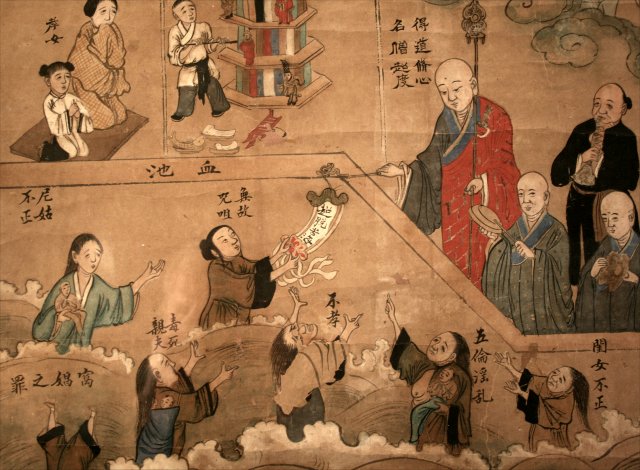
A second example of the pool of blood and filth from another hell scroll (S9). Sins here include sexual improprieties, bringing chaos to proper human relationships, cursing someone for no good reason and a lack of filial piety.
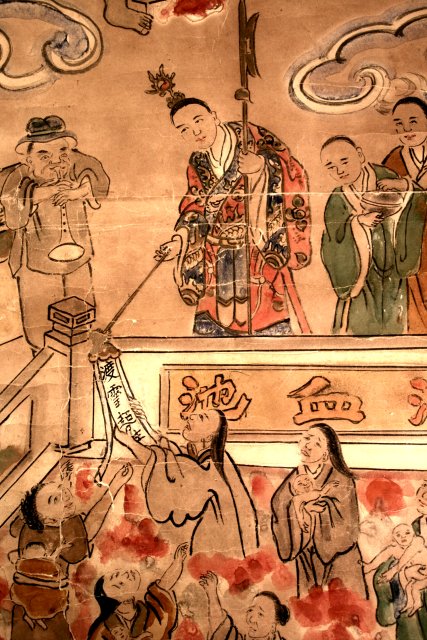
A third example of the pool of blood and filth from another hell scroll (C4).
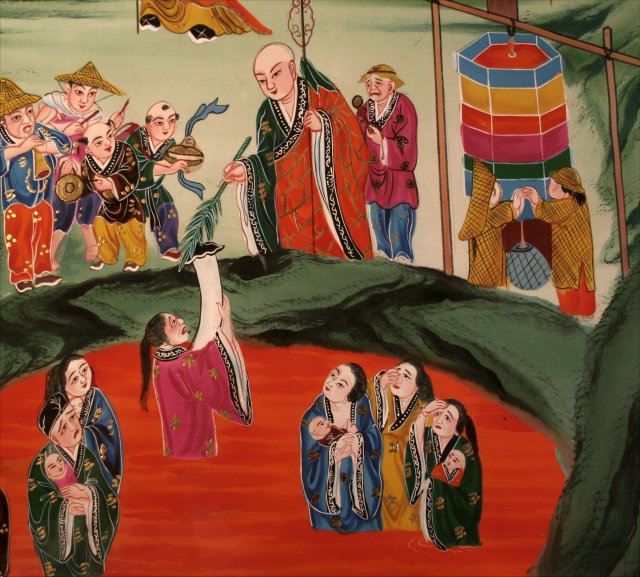
A fourth example of the pool of blood and filth from another hell scroll (E2).
